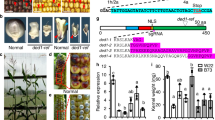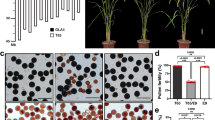Abstract
Hybrid seed lethality is a widespread type of reproductive barrier among angiosperm taxa1,2 that contributes to species divergence by preventing gene flow between natural populations3,4. Besides its ecological importance, it is an important obstacle to plant breeding strategies5. Hybrid seed lethality is mostly due to a failure of the nourishing endosperm tissue, resulting in embryo arrest3,6,7. The cause of this failure is a parental dosage imbalance in the endosperm that can be a consequence of either differences in parental ploidy levels or differences in the 'effective ploidy', also known as the endosperm balance number (EBN)8,9. Hybrid seed defects exhibit a parent-of-origin pattern3,6,7, suggesting that differences in number or expression strength of parent-of-origin-specific imprinted genes underpin, as the primary or the secondary cause, the molecular basis of the EBN7,10. Here, we have tested this concept in the genus Capsella and show that the effective ploidy of three Capsella species correlates with the number and expression level of paternally expressed genes (PEGs). Importantly, the number of PEGs and the effective ploidy decrease with the selfing history of a species: the obligate outbreeder Capsella grandiflora had the highest effective ploidy, followed by the recent selfer Capsella rubella and the ancient selfer Capsella orientalis. PEGs were associated with the presence of transposable elements and their silencing mark, DNA methylation in CHH context (where H denotes any base except C). This suggests that transposable elements have driven the imprintome divergence between Capsella species. Together, we propose that variation in transposable element insertions, the resulting differences in PEG number and divergence in their expression level form one component of the effective ploidy variation between species of different breeding system histories, and, as a consequence, allow the establishment of endosperm-based hybridization barriers.
This is a preview of subscription content, access via your institution
Access options
Access Nature and 54 other Nature Portfolio journals
Get Nature+, our best-value online-access subscription
$29.99 / 30 days
cancel any time
Subscribe to this journal
Receive 12 digital issues and online access to articles
$119.00 per year
only $9.92 per issue
Buy this article
- Purchase on Springer Link
- Instant access to full article PDF
Prices may be subject to local taxes which are calculated during checkout



Similar content being viewed by others
References
Ramsey, J. & Schemske, D. W. Pathways, mechanisms, and rates of polyploid formation in flowering plants. Annu. Rev. Ecol. Syst. 29, 467–501 (1998).
Lafon-Placette, C. & Köhler, C. Endosperm-based postzygotic hybridization barriers: developmental mechanisms and evolutionary drivers. Mol. Ecol. 25, 2620–2629 (2016).
Lafon-Placette, C. et al. Endosperm-based hybridization barriers explain the pattern of gene flow between Arabidopsis lyrata and Arabidopsis arenosa in Central Europe. Proc. Natl Acad. Sci. USA 114, E1027–E1035 (2017).
Hämälä, T., Mattila, T. M., Leinonen, P. H., Kuittinen, H. & Savolainen, O. Role of seed germination in adaptation and reproductive isolation in Arabidopsis lyrata. Mol. Ecol. 26, 3484–3496 (2017).
Sahijram, L. & Rao, B. M. in Plant Biology and Biotechnology 363–384 (Springer, New Delhi, 2015).
Rebernig, C. A., Lafon-Placette, C., Hatorangan, M. R., Slotte, T. & Köhler, C. Non-reciprocal interspecies hybridization barriers in the Capsella Genus are established in the endosperm. PLoS Genet. 11, e1005295 (2015).
Florez-Rueda, A. M. et al. Genomic imprinting in the endosperm is systematically perturbed in abortive hybrid tomato seeds. Mol. Biol. Evol. 33, 2935–2946 (2016).
Johnston, S. A. & Hanneman, R. E. Manipulations of endosperm balance number overcome crossing barriers between diploid Solanum species. Science 217, 446–448 (1982).
Birchler, J. A. Interploidy hybridization barrier of endosperm as a dosage interaction. Front. Plant Sci. 5, 281 (2014).
Wolff, P., Jiang, H., Wang, G., Santos-González, J. & Köhler, C. Paternally expressed imprinted genes establish postzygotic hybridization barriers in Arabidopsis thaliana. eLife Sci. 4, e10074 (2015).
Kirkbride, R. C. et al. An epigenetic role for disrupted paternal gene expression in postzygotic seed abortion in Arabidopsis interspecific hybrids. Mol. Plant 8, 1766–1775 (2015).
Douglas, G. M. et al. Hybrid origins and the earliest stages of diploidization in the highly successful recent polyploid Capsella bursa-pastoris. Proc. Natl Acad. Sci. 112, 2806–2811 (2015).
Sicard, A. et al. Divergent sorting of a balanced ancestral polymorphism underlies the establishment of gene-flow barriers in Capsella. Nat. Commun. 6, 7960 (2015).
Scott, R. J., Spielman, M., Bailey, J. & Dickinson, H. G. Parent-of-origin effects on seed development in Arabidopsis thaliana. Development 125, 3329–3341 (1998).
Hatorangan, M. R., Laenen, B., Steige, K., Slotte, T. & Köhler, C. Rapid evolution of genomic imprinting in two species of the Brassicaceae. Plant Cell 28, 1815–1827 (2016).
Klosinska, M., Picard, C. L. & Gehring, M. Conserved imprinting associated with unique epigenetic signatures in the Arabidopsis genus. Nat. Plants 2, 16145 (2016).
Varrault, A. et al. Zac1 regulates an imprinted gene network critically involved in the control of embryonic growth. Dev. Cell 11, 711–722 (2006).
Rodrigues, J. A. & Zilberman, D. Evolution and function of genomic imprinting in plants. Genes Dev. 29, 2517–2531 (2015).
Ågren, J. A. et al. Mating system shifts and transposable element evolution in the plant genus Capsella. BMC Genom. 15, 602 (2014).
Boutin, T. S., Le Rouzic, A. & Capy, P. How does selfing affect the dynamics of selfish transposable elements? Mob. DNA 3, 5 (2012).
St. Onge, K. R., Källman, T., Slotte, T., Lascoux, M. & Palmé, A. E. Contrasting demographic history and population structure in Capsella rubella and Capsella grandiflora, two closely related species with different mating systems. Mol. Ecol. 20, 3306–3320 (2011).
Hurka, H., Friesen, N., German, D. A., Franzke, A. & Neuffer, B. ‘Missing link’ species Capsella orientalis and Capsella thracica elucidate evolution of model plant genus Capsella (Brassicaceae). Mol. Ecol. 21, 1223–1238 (2012).
Seymour, D. K., Koenig, D., Hagmann, J., Becker, C. & Weigel, D. Evolution of DNA methylation patterns in the Brassicaceae is driven by differences in genome organization. PLoS Genet. 10, e1004785 (2014).
Krueger, F. & Andrews, S. R. Bismark: a flexible aligner and methylation caller for Bisulfite-Seq applications. Bioinformatics 27, 1571–1572 (2011).
Ramírez, F., Dündar, F., Diehl, S., Grüning, B. A. & Manke, T. deepTools: a flexible platform for exploring deep-sequencing data. Nucl. Acids Res. 42, 187–191 (2014).
Bewick, A. J. et al. FASTmC: a suite of predictive models for nonreference-based estimations of DNA methylation. G3 (Bethesda) 6, 447–452 (2015).
Anders, S., Pyl, P. T. & Huber, W. HTSeq-150; a Python framework to work with high-throughput sequencing data. Bioinformatics 31, 166–169 (2014).
Belmonte, M. F. et al. Comprehensive developmental profiles of gene activity in regions and subregions of the Arabidopsis seed. Proc. Natl Acad. Sci. 110, 435–444 (2013).
Anders, S. & Huber, W. Differential expression analysis for sequence count data. Genome Biol. 11, R106 (2010).
Acknowledgements
Sequencing was performed by the SNP&SEQ Technology Platform, Science for Life Laboratory at Uppsala University, a national infrastructure supported by the Swedish Research Council (VRRFI) and the Knut and Alice Wallenberg Foundation. This research was supported by a European Research Council Starting Independent Researcher grant (to C.K.). C.L.-P. was supported by a grant from the Nilsson-Ehle Foundation.
Author information
Authors and Affiliations
Contributions
C.L.-P., M.R.H. and C.K. designed research. C.L.-P. and M.R.H. performed the experiments. A.C., K.A.S., T.S. and M.L. characterized the plant material. C.L.-P., M.R.H. and C.K. analysed the data. C.L.-P., M.R.H. and C.K. wrote the paper.
Corresponding author
Ethics declarations
Competing interests
The authors declare no competing interests.
Additional information
Publisher’s note: Springer Nature remains neutral with regard to jurisdictional claims in published maps and institutional affiliations.
Supplementary information
Supplementary Information
Supplementary Figures 1–8, Supplementary Table 1, Supplementary Table 3–5 and Supplementary Table 7
Supplementary Table 2
List of imprinted genes in C. grandiflora, C. rubella and C. orientalis. Cr, C. rubella; Cg, C. grandiflora; Co, C. orientalis; M, maternal allele count; P, paternal allele count; Chi2pval, Chi-square test corrected P value; MEG, maternally expressed gene; PEG, paternally expressed gene
Supplementary Table 6
Raw and normalized read counts for reciprocal crosses CgA × CgB, CrA × CrB and CoA × CoB. Genes were classified as ‘passed’ if, in at least one library of the CgA × CgB reciprocal crosses and in one library of the Cr A × Cr B reciprocal crosses, the expression level was equal or higher than 80% of the expression level in Cr or Cg seeds, respectively
Supplementary Table 8
Calculation of false discovery rate (FDR) of detecting non-endosperm-preferred genes prior and post filtering. The FDR of detecting non-endosperm-preferred genes prior and post filtering was calculated based on the 50 most highly expressed genes in seed coat and embryo samples of heart stage A. thaliana seeds
Rights and permissions
About this article
Cite this article
Lafon-Placette, C., Hatorangan, M.R., Steige, K.A. et al. Paternally expressed imprinted genes associate with hybridization barriers in Capsella. Nature Plants 4, 352–357 (2018). https://doi.org/10.1038/s41477-018-0161-6
Received:
Accepted:
Published:
Issue Date:
DOI: https://doi.org/10.1038/s41477-018-0161-6
This article is cited by
-
Selfish conflict underlies RNA-mediated parent-of-origin effects
Nature (2024)
-
Transcriptome-wide identification and characterization of genes exhibit allele-specific imprinting in maize embryo and endosperm
BMC Plant Biology (2023)
-
Epigenetic modifications potentially controlling the allelic expression of imprinted genes in sunflower endosperm
BMC Plant Biology (2021)
-
Accurate determination of genotypic variance of cell wall characteristics of a Populus trichocarpa pedigree using high-throughput pyrolysis-molecular beam mass spectrometry
Biotechnology for Biofuels (2021)
-
The evolution of imprinting in plants: beyond the seed
Plant Reproduction (2021)



